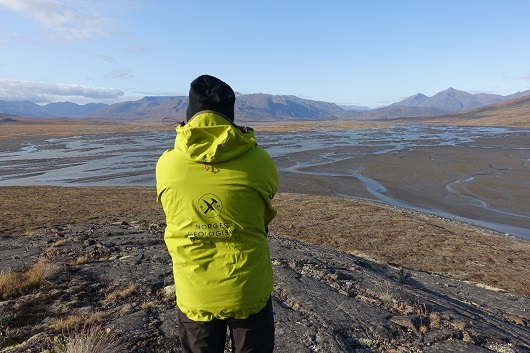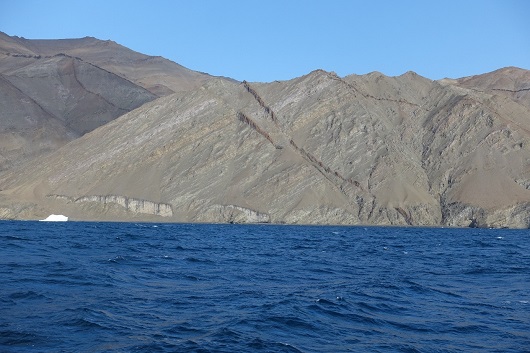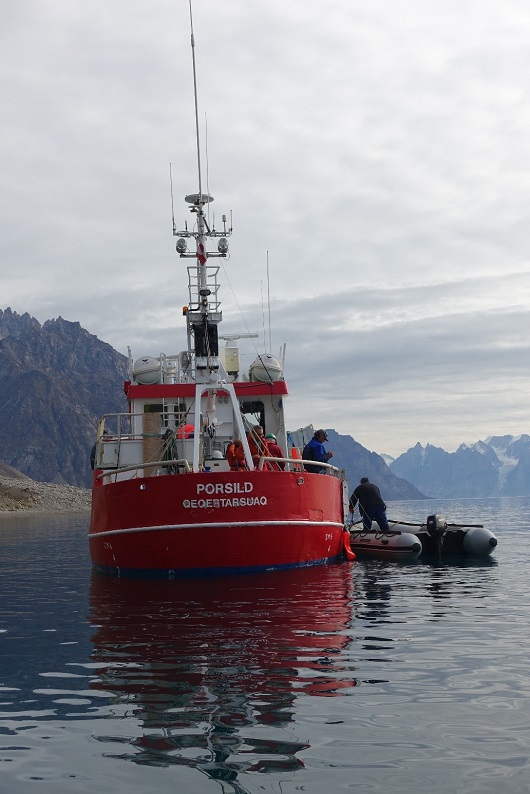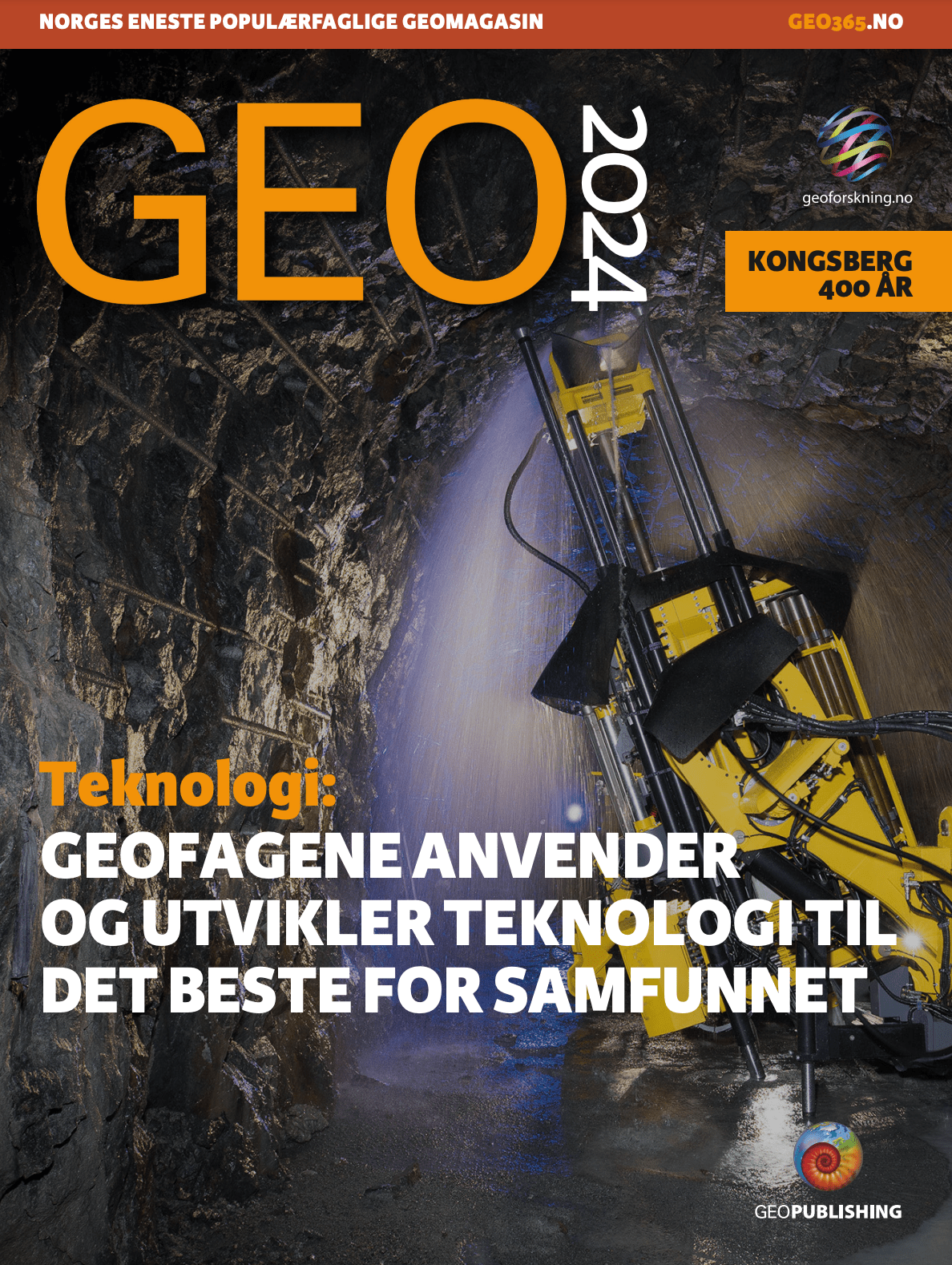Vulkanske bergarter på Grønland lar geologene lære mer om Atlanterhavets dannelse og utvikling. NGUs Laurent Gernigon rapporterer fra felt.
 Laurent foran platåbasalt (Tertiary flood basalts) på Nuussuaq-halvøya på Grønland. Alle foto: Laurent Gernigon
Laurent foran platåbasalt (Tertiary flood basalts) på Nuussuaq-halvøya på Grønland. Alle foto: Laurent Gernigon
Det ligger mye «god» vulkanisme bak åpningen av et hav. Dette gjaldt også for Atlanterhavet som ble dannet for om lag 55 millioner år siden.
Hendelsen resulterte i høy vulkansk aktivitet, og enorme mengder magma ble presset opp og avsatt mellom det som i dag er Norge og Grønland. Under store deler av de norske og grønlandske kontinentalmarginene ligger det derfor basaltlag.
De vulkanske bergartene er av stor vitenskapelig verdi fordi de gir innsikt i den geologiske historien i vår del av verden og hvordan den faste jord, havet, atmosfæren, kryosfæren og klimaet virker sammen.
Bergartene er også av interesse for petroleumsindustrien fordi store mengder olje og gass kan eksistere i og under basalten (på norsk sokkel i Norskehavet).
Det er imidlertid ikke enkelt å studere bergarter på havets bunn. Derfor valfarter geofaglige forskere til Grønland, der disse kan studeres i detalj på land.
Forsker Laurent Gernigon fra Norges geologiske undersøkelse (NGU) reiste nylig til Vest-Grønland sammen med et knippe internasjonale forskere.
Les Laurent Gernigons feltrapport i sin helhet på engelsk under:
 Hyaloclastites formation observed at the Niaqornat village. It represents a good analogue of the lava delta formation formed along the Early Eocene paleoshoreline recognised in the distal part of the Mid-Norwegian margin.
Hyaloclastites formation observed at the Niaqornat village. It represents a good analogue of the lava delta formation formed along the Early Eocene paleoshoreline recognised in the distal part of the Mid-Norwegian margin.
A Week Journeying Across the West Greenland Volcanic Margin
From 2016 to 2019, a series of North Atlantic Workshops was organized at Durham University by Prof. Gillian Foulger together with Drs. Christian Schiffer and Alexander Peace.
The series united a number of international experts on the NE Atlantic region including from BGR (Bundesanstalt für Geowissenschaften und Rohstoffe), Brest University, Durham University, Equinor, the Australian School of Petroleum, Hawaii University, University of Miami, University of Aberdeen, Imperial College London, University of Iceland and NGU (Norges Geologiske Undersøkelse).
The central theme of the workshop series was the evolution of the North Atlantic Realm and tectonic development of related volcanic margins.
The recent unprecedented surge in exploration of this vast region has delivered major leaps forward in understanding its geological structure, dynamics and magmatic development.
 Participant of the 2019 West Greenland expedition. From Left to Right. Dr. Rüdiger Lutz (BGR), Prof. Laurent Geoffroy (University of Brest), Prof. Gianreto Manatschal (University of Strasbourg), Prof. Bruce Julian (University of Durham), Prof. Gillian Foulger (University of Durham), Dr. Dieter Franke (BGR) and Dr. Laurent Gernigon (NGU).
Participant of the 2019 West Greenland expedition. From Left to Right. Dr. Rüdiger Lutz (BGR), Prof. Laurent Geoffroy (University of Brest), Prof. Gianreto Manatschal (University of Strasbourg), Prof. Bruce Julian (University of Durham), Prof. Gillian Foulger (University of Durham), Dr. Dieter Franke (BGR) and Dr. Laurent Gernigon (NGU).
Geophysical and petrological data, isostatic studies and other observations suggest that the volcanic margins are fundamentally different from so-called “magma-poor” margins.
Atypical margins lie offshore mid-Norway and onshore/offshore West Greenland. They are characterized by vast volcanic outpourings that build voluminous volcanic seaward dipping reflector sequences (SDR) that form during the opening of new oceans.
Volcanic trap emplacement also coincides with regional injection of thousands of km3 of magma into adjacent sedimentary basins and underlying basement rocks.
In Norway, this catastrophic magmatic event has been correlated with a major climatic change (the so-called Paleocene-Eocene Thermal Maxima, e.g., Svensen et al., 2004).
 Pre-Volcanic and shallow marine formation (sand and coals layers) lying directly on top of weathered basement.
Pre-Volcanic and shallow marine formation (sand and coals layers) lying directly on top of weathered basement.
Detailed understanding of the interdependencies of these phenomena in the past and through time is needed to understand lithospheric rupture on Earth and is arguably critical to understanding rapid climate evolution.
Nevertheless, the mode of conjugate volcanic margins development and the role of lithospheric/asthenospheric interaction leading to rupture of the continental plates remain unclear and controversial (Abdelmalak et al., 2016; Geoffroy et al., 2015; Guan et al., 2019; Zastrozhnov et al., 2018).
Recent geophysical data acquisition, and hypotheses discussed during the Durham workshops, raise the possibility of widespread continental crust beneath the Greenland-Iceland-Faroe bathymetric ridge (Foulger et al., in press) and explore the processes leading to diachronic volcanic margin formation and breakup(s) of the Norwegian-Greenland Sea (Gernigon et al., in press; Franke et al., in press).
To investigate better the structure and the magmatic processes involved during the onset of breakup, NGU together with colleagues from BGR, Durham and the Universities of Brest and Strasbourg undertook an expedition to investigate the innermost part of the W Greenland volcanic margin where Inner SDRs are fully exposed in the Svartenhuk area (West of the Nuussuaq Peninsula, West Greenland).
 Seaward dipping volcanic wedges of the Svartenhuk Peninsula faulted and intruded by dikes during the onset of breakup.
Seaward dipping volcanic wedges of the Svartenhuk Peninsula faulted and intruded by dikes during the onset of breakup.
Along the Nuussuaq fjord, syn-tectonic basaltic lavas indicate that continental stretching and thinning occurred during Paleocene time giving an Eocene lower boundary age for breakup in Baffin Bay (e.g., Chauvet et al., 2019).
The volcanic sequences exposed in West Greenland are amazingly similar to those interpreted offshore mid-Norway (e.g., Planke et al., 2017) and offer the advantage of being studied onshore.
Our observations bear on the interaction between magmatism and sedimentation and provided new insights and comparisons regarding the mode of deformation during magmatic transition from continent to ocean.
Interdisciplinary study of the North Atlantic region and the quest for potential analogues for the distal part of the mid-Norwegian margin offer an extraordinary opportunity to advance understanding of interactions and co-dependencies between the solid Earth, ocean, atmosphere, cryosphere and climate.
Understanding these issues are important for Nordic countries and the hydrocarbon industry and are also of global relevance to the issue of climate change.
Expanding activity on the Nordic volcanic margins will continue to interest NGU, together with several European institutions, also involved in the current IODP (International Ocean Discovery Program) proposal titled “The Nature, Cause and Climate Implications of Excess Magmatism During the Northeast Atlantic Continental Breakup».
 Outstanding geological landscape and arctic views on the Ummanaq Fjord.
Outstanding geological landscape and arctic views on the Ummanaq Fjord.
 Prof. Laurent Geoffroy (expedition leader) showing us the flow direction of the basaltic compound lava flows during the flood basalt emplacement.
Prof. Laurent Geoffroy (expedition leader) showing us the flow direction of the basaltic compound lava flows during the flood basalt emplacement.
 Picture of the Porsild research ship used for transportation and accommodation during the expedition. The boat belongs to the Arctic station of the Copenhagen University and is often used for all kinds of research tasks including marine Biology and Geology.
Picture of the Porsild research ship used for transportation and accommodation during the expedition. The boat belongs to the Arctic station of the Copenhagen University and is often used for all kinds of research tasks including marine Biology and Geology.



